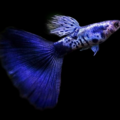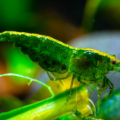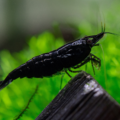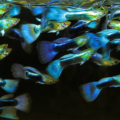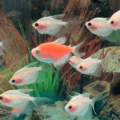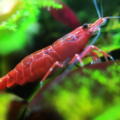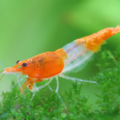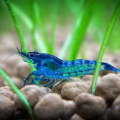Learn the best ways to care for your Blue Velvet shrimp and promote healthy reproduction with the tips in this guide! These elegant blue beauties are a must-have for any aquarium.

Colorful aquarium shrimp are our favorite species to rave about – join us on this wild ride through the world of the Blue Velvet shrimp!
The Blue Velvet shrimp is the pinnacle of aesthetic appeal for a Neocaridina species with their cerulean blue hue that adds a touch of elegance to any aquarium setup.
Extending to almost 2 inches in adult length, you will never forget your first encounter with this vibrant freshwater shrimp. They’re also known for their peaceful temperament, which has made them suitable for a range of aquariums.
- Color Pattern: The Blue Velvet shrimp’s appearance is, however, subject to slight variations based on diet and tank lighting. This means that if you keep them in groups, it’s pretty standard for you to see different shades of their rich blue color.
- Unique Trait: If you’re looking to keep/breed hardy shrimps that are tolerant enough to withstand harsh water conditions, calm, and well-behaved in a community tank, then the Blue Velvet should be first on your list.
Setting Up the Perfect Tank for Blue Velvet Shrimp
There are a few freshwater shrimp tank essentials you must follow to protect and promote your pet’s growth. To be more precise, the recommended minimum tank size for the Blue Velvet shrimp is 3-6 gallons (10-20 liters) to help ensure stable water parameters.
Neocaridina shrimp, including Blue Velvet, love live plants like willow, moss, and baby tears, which provide cover and oxygen in aquarium setups for shrimps, thus providing a healthy environment.
- Tank Requirements: For stable water parameters, you need a pH range between 6.8 to 7.5 and a temperature range of 720 to 82oF. Sponge filters are also essential; they help prevent your shrimp from being sucked in by strong water flow.
- Substrate and Decorations: For a Blue Velvet shrimp tank setup, we recommend you get a finely textured substrate. You can opt for a dark substrate to create a beautiful contrast in your tank and include a few plants to provide hiding spots for your shrimp.

Feeding Blue Velvet Shrimp: Diet and Color Enhancement
Blue Velvet shrimp diet is an essential aspect of their care, which requires utmost attention. These blue beauties are omnivores who devour a range of food varieties, from algae wafers and shrimp-specific pellets to blanched vegetables like carrots, broccoli, and spinach. A balanced diet is also pivotal to enhancing shrimp color.
- Diet Suggestions: For growth and vibrant colors, go all out with a high-quality, plant-based, and calcium-rich diet with occasional protein meals.
- Feeding Tips: Aquarium shrimp feeding is somewhat tricky due to the probability of overfeeding, and overfeeding comes with dire consequences. Now, how do you manage that? It’s simple: maintain a feeding frequency of 2-3 times daily and quickly clear your tank of food remnants or only feed what your aquatic pets can eat in a few minutes to prevent water contamination.
One more thing: if your tank is filled with biofilm and detritus, you can reduce your feeding cycle to once per day, as all the above are excellent naturally occurring food sources.
For more on feeding your aquatic pets check out The Ultimate Guide to Fish Food: Pros and Cons & Best Choices!
Breeding Blue Velvet Shrimp: Steps for Success

Blue Velvet shrimp are highly adaptable to any environment, but maintaining stable parameters is essential to promote a healthy mating and hatching process.
Breeding aquarium shrimp is an easy process that begins with the female shrimp secreting pheromones to lure the male species to mate after molting. At the end of the mating process, the berried female shrimp carries about 30-35 eggs in a cluster beneath its tail, eliminating the chances of eggs laying carelessly in the tank.
This video has been very helpful in identifying the sex of Neocaridina Shrimp, I highly recommend it:
After 2-3 weeks in their mother’s cluster, the shrimplets hatch as small versions of the adult if not in a mixed variation tank which would eventually result in shrimplets taking on a wild coloration.
- Breeding Environment: The freshwater shrimp reproduction process requires optimal water conditions to promote egg survival and protect young shrimp when they hatch. Keep your water temperature between 720 to 82oF and pH level under 7.5, but never below 6.8. Maintain low ammonia, nitrate, and nitrite levels in your water, and look out for high copper volume.
- Egg and Juvenile Care: Blue Velvet shrimp juvenile care post-hatching is almost seamless as the shrimplets begin exhibiting adult traits, like food gathering, once they break out of their shell. Ensure they have enough hiding spots to retreat and rest when stressed.
Blue Velvet shrimp breeding is also very rewarding as your baby shrimp can become parents as early as 3-5 months after hatching. This means 10 shrimps can produce 100 shrimplets before a calendar year runs out.
Best Tank Mates for Blue Velvet Shrimp

Blue Velvet shrimp is one of the friendliest freshwater pets around and coexist well with other non violent aquatic species. When it comes to selecting Blue Velvet shrimp tank mates, there are a few things to know.
- Compatible species: Small tetras, snails, guppies, danios, Asian stone catfish, vampire shrimps, and other non-aggressive species are great occupants in your peaceful community aquarium.
- Incompatible Species: Avoid goldfish, discus, crayfish, angelfish, plecos, and any large fish absent from the list of compatible fish for shrimp tanks. Shrimp is typically apart of a large fish’s diet, and I’m sure you don’t want your pet to become dinner.
Maintaining Health in Blue Velvet Shrimp
A freshwater shrimp care guide is incomplete without helpful health tips; let’s get into it!
Blue Velvet shrimp are easy to keep and feed. Still, they can become prone to diseases such as molting issues and sensitivity to copper, which typically results in death. Symptoms to look out for in a sick shrimp include lethargy, color fading, or poorly formed molts.
A few Blue Velvet shrimp health tips we’ll give you are to perform regular water changes, maintain stable water parameters, and monitor your shrimp regularly to help spot ailing shrimp early. Another great hack for preventing shrimp illnesses is to avoid copper-based treatments and test the copper levels in tap water before adding it to your aquarium.
Maximizing the Lifespan of Blue Velvet Shrimp

Nothing good lasts forever, and sadly, you can only get 1-2 years maximum out of your Blue Velvet shrimp, even with proper care. However sturdy you think your shrimps are, they are also quite sensitive, and factors such as water conditions, feeding habits, and physical stress levels can all affect your Blue Velvet shrimp’s lifespan.
- Lifespan Factors: The water quality in your home tank, diet, and stress levels can all seriously influence freshwater shrimp longevity, so keep things pristine at all times.
- Care Tips for Longevity: Extending shrimp life is serious and shouldn’t be taken with a pinch of salt. Ensuring and enforcing premium maintenance routines, including regular water changes, quarantine, and temperature checks with standard feeding practices, all contribute to a longer life.
Conclusion
Here’s a pat on the back for making it here! One point remains central in this Blue Velvet shrimp care guide: the ease with which beginners and experienced aquarists can engage in freshwater shrimp maintenance to get visible results.
These tank beauties are beginner-friendly, have warm personalities, and are easy to care for; adding them to your tank brings charm and color to your aquarium.
Blue Velvet shrimp also require a clean and stable tank to help maintain their health and vibrant color, so use the beginner shrimp tips in this guide at your discretion to get the most out of your new pets.
Of course, we encourage you to continue learning about your shrimp at your own pace, which will allow you to discover other care requirements you can incorporate into your routine.

